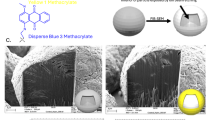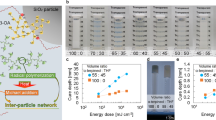Abstract
Slurries with high solid content and low viscosity are highly necessary to lower the sintering shrinkage and avoid possible defects for ceramic components fabricated by vat photopolymerization technique. However, the viscosity of slurry dramatically arises with the increase of solid content, which severely affects the printing process and the quality of preformance. To solve this issue, a novel combined strategy of powder surface modification and selection of dispersant was proposed to significantly increase the solid load without too much increase in viscosity. The surface of Al2O3 particles was modified by Silane A174 to improve its wettability with resins, and then the use of KOS 110 formed steric hindrance between particles achieving good dispersion. The synergistic effect of the modifier and dispersant was realized. Al2O3 slurry with a high solid loading up to 65 vol% and low viscosity of 20.0 Pa·s at 30 s−1 was prepared for stereolithography-based DLP 3D printing, which had among the highest performance in photosensitive Al2O3 slurries.











Similar content being viewed by others
Data availability
The data that support the findings of this study are available from the corresponding author upon reasonable request.
References
H. Wu, W. Liu, R. He, Z. Wu, Q. Jiang, X. Song, Y. Chen, L. Cheng, S. Wu, Fabrication of dense zirconia-toughened alumina ceramics through a stereolithography-based additive manufacturing. Ceram. Int. 43, 968–972 (2017). https://doi.org/10.1016/j.ceramint.2016.10.027
J. Ebert, E. Oezkol, A. Zeichner, K. Uibel, O. Weiss, U. Koops, R. Telle, H. Fischer, Direct inkjet printing of dental prostheses made of Zirconia. J. Dent. Res. 88, 673–676 (2009). https://doi.org/10.1177/0022034509339988
K. Prabhakaran, C. Pavithran, Gelcasting of alumina from acidic aqueous medium using acrylic acid. J. Eur. Ceram. Soc. 20, 1115–1119 (2000). https://doi.org/10.1016/s0955-2219(99)00244-7
M.M. Seabaugh, G.L. Messing, M.D. Vaudin, Texture development and microstructure evolution in liquid-phase-sintered alpha-alumina ceramics prepared by templated grain growth. J. Am. Ceram. Soc. 83, 3109–3116 (2000). https://doi.org/10.1111/j.1151-2916.2000.tb01690.x
M. Hegde, V. Meenakshisundaram, N. Chartrain, S. Sekhar, D. Tafti, C.B. Williams, T.E. Long, 3D printing all-aromatic polyimides using mask-projection stereolithography: processing the nonprocessable. Adv. Mater. (2017). https://doi.org/10.1002/adma.201701240
D.K. Patel, A.H. Sakhaei, M. Layani, B. Zhang, Q. Ge, S. Magdassi, Highly stretchable and UV curable elastomers for digital light processing based 3D printing. Adv. Mater. (2017). https://doi.org/10.1002/adma.201606000
T. Yao, Z. Deng, K. Zhang, S. Li, A method to predict the ultimate tensile strength of 3D printing polylactic acid (PLA) materials with different printing orientations. Compos. Part B Eng. 163, 393–402 (2019). https://doi.org/10.1016/j.compositesb.2019.01.025
X.-W. Ren, L. Zeng, Z.-M. Wei, X.-Z. Xin, B. Wei, Effects of multiple firings on metal-ceramic bond strength of Co-Cr alloy fabricated by selective laser melting. J. Prosthet. Dent. 115, 109–114 (2016). https://doi.org/10.1016/j.prosdent.2015.03.023
Z. Chen, Z. Li, J. Li, C. Liu, C. Lao, Y. Fu, C. Liu, Y. Li, P. Wang, Y. He, 3D printing of ceramics: a review. J. Eur. Ceram. Soc. 39, 661–687 (2019). https://doi.org/10.1016/j.jeurceramsoc.2018.11.013
J.-W. Choi, R. Wicker, S.-H. Lee, K.-H. Choi, C.-S. Ha, I. Chung, Fabrication of 3D biocompatible/biodegradable micro-scaffolds using dynamic mask projection microstereolithography. J. Mater. Process. Technol. 209, 5494–5503 (2009). https://doi.org/10.1016/j.jmatprotec.2009.05.004
Y. Pan, Y. Chen, Z. Yu, Fast mask image projection-based micro-stereolithography process for complex geometry. J. Micro Nano Manuf. (2017). https://doi.org/10.1115/1.4035388
J.C. Liu, J.H. Jean, C.C. Li, Dispersion of nano-sized 7-alumnina powder in non-polar solvents. J. Am. Ceram. Soc. 89, 882–887 (2006). https://doi.org/10.1111/j.1551-2916.2005.00858.x
C.V. Adake, P. Bhargava, P. Gandhi, Effect of surfactant on dispersion of alumina in photopolymerizable monomers and their UV curing behavior for microstereolithography. Ceram. Int. 41, 5301–5308 (2015). https://doi.org/10.1016/j.ceramint.2014.12.066
K. Li, Z. Zhao, The effect of the surfactants on the formulation of UV-curable SLA alumina suspension. Ceram. Int. 43, 4761–4767 (2017). https://doi.org/10.1016/j.ceramint.2016.11.143
A. Goswami, K. Ankit, N. Balashanmugam, A.M. Umarji, G. Madras, Optimization of rheological properties of photopolymerizable alumina suspensions for ceramic microstereolithography. Ceram. Int. 40, 3655–3665 (2014). https://doi.org/10.1016/j.ceramint.2013.09.059
X. Xu, S. Zhou, J. Wu, Q. Zhang, Y. Zhang, G. Zhu, Preparation of highly dispersive solid microspherical alpha-Al2O3 powder with a hydrophobic surface for stereolithography-based 3D printing technology. Ceram. Int. 46, 1895–1906 (2020). https://doi.org/10.1016/j.ceramint.2019.09.167
H. Xing, B. Zou, Q. Lai, C. Huang, Q. Chen, X. Fu, Z. Shi, Preparation and characterization of UV curable Al2O3 suspensions applying for stereolithography 3D printing ceramic microcomponent. Powder Technol. 338, 153–161 (2018). https://doi.org/10.1016/j.powtec.2018.07.023
J. Sun, J. Binner, J. Bai, Effect of surface treatment on the dispersion of nano zirconia particles in non-aqueous suspensions for stereolithography. J. Eur. Ceram. Soc. 39, 1660–1667 (2019). https://doi.org/10.1016/j.jeurceramsoc.2018.10.024
K. Zhang, R. He, C. Xie, G. Wang, G. Ding, M. Wang, W. Song, D. Fang, Photosensitive ZrO2 suspensions for stereolithography. Ceram. Int. 45, 12189–12195 (2019). https://doi.org/10.1016/j.ceramint.2019.03.123
K. Zhang, Q. Meng, N. Cai, Z. Qu, R. He, Effects of solid loading on stereolithographic additive manufactured ZrO2 ceramic: a quantitative defect study by X-ray computed tomography. Ceram. Int. 47, 24353–24359 (2021). https://doi.org/10.1016/j.ceramint.2021.05.149
K. Zhang, C. Xie, G. Wang, R. He, G. Ding, M. Wang, D. Dai, D. Fang, High solid loading, low viscosity photosensitive Al2O3 slurry for stereolithography based additive manufacturing. Ceram. Int. 45, 203–208 (2019). https://doi.org/10.1016/j.ceramint.2018.09.152
M. Borlaf, N. Szubra, A. Serra-Capdevila, W.W. Kubiak, T. Graule, Fabrication of ZrO2 and ATZ materials via UV-LCM-DLP additive manufacturing technology. J. Eur. Ceram. Soc. 40, 1574–1581 (2020). https://doi.org/10.1016/j.jeurceramsoc.2019.11.037
Y. Wang, Z. Wang, S. Liu, Z. Qu, Z. Han, F. Liu, L. Li, Additive manufacturing of silica ceramics from aqueous acrylamide based suspension. Ceram. Int. 45, 21328–21332 (2019). https://doi.org/10.1016/j.ceramint.2019.07.118
D.A. Komissarenko, P.S. Sokolov, A.D. Evstigneeva, I.A. Shmeleva, A.E. Dosovitsky, Rheological and curing behavior of acrylate-based suspensions for the DLP 3D printing of complex zirconia parts. Materials (2018). https://doi.org/10.3390/ma11122350
E. Johansson, O. Lidstrom, J. Johansson, O. Lyckfeldt, E. Adolfsson, Influence of resin composition on the defect formation in alumina manufactured by stereolithography. Materials (2017). https://doi.org/10.3390/ma10020138
I.M. Krieger, T.J. Dougherty, A mechanism for non-Newtonian flow in suspensions of rigid spheres. Trans. Soc. Rheol. 3, 137–152 (1959). https://doi.org/10.1122/1.548848
L. Struble, G.K. Sun, Viscosity of portland-cement paste as a function of concentration. Adv. Cem. Based Mater. 2, 62–69 (1995). https://doi.org/10.1016/1065-7355(94)00023-7
I.M. Krieger, Rheology of monodisperse latices. Adv. Colloid Interface Sci 3, 111–136 (1972). https://doi.org/10.1016/0001-8686(72)80001-0
R.C. Ball, P. Richmond, Dynamics of colloidal dispersions. Phys. Chem. Liq. 9, 99–116 (1980). https://doi.org/10.1080/00319108008084770
A. Ghanbari, B.L. Karihaloo, Prediction of the plastic viscosity of self-compacting steel fibre reinforced concrete. Cem. Concr. Res. 39, 1209–1216 (2009). https://doi.org/10.1016/j.cemconres.2009.08.018
M.L. Griffith, J.W. Halloran, Freeform fabrication of ceramics via stereolithography. J. Am. Ceram. Soc. 79, 2601–2608 (1996). https://doi.org/10.1111/j.1151-2916.1996.tb09022.x
Y. Yu, B. Zou, X. Wang, C. Huang, Rheological behavior and curing deformation of paste containing 85 wt% Al2O3 ceramic during SLA-3D printing. Ceram. Int. 48, 24560–24570 (2022). https://doi.org/10.1016/j.ceramint.2022.05.099
Acknowledgements
This work was supported by Shandong University-MSEA International Institute for Materials Genome Joint Innovation Center for Advanced Ceramics and the Key R & D projects in Shanxi Province (no. 2018ZDCXL-GY-09-06 and 2021ZDLGY14-06).
Author information
Authors and Affiliations
Corresponding author
Ethics declarations
Conflict of interest
The authors declare that they do not have any commercial or associative interest that represents a conflict of interest in connection with the work submitted.
Additional information
Publisher's Note
Springer Nature remains neutral with regard to jurisdictional claims in published maps and institutional affiliations.
Rights and permissions
Springer Nature or its licensor (e.g. a society or other partner) holds exclusive rights to this article under a publishing agreement with the author(s) or other rightsholder(s); author self-archiving of the accepted manuscript version of this article is solely governed by the terms of such publishing agreement and applicable law.
About this article
Cite this article
Zhang, X., Zhang, J., Tian, Y. et al. Photosensitive Al2O3 slurry with high solid content and low viscosity. J. Korean Ceram. Soc. 60, 581–590 (2023). https://doi.org/10.1007/s43207-023-00286-5
Received:
Revised:
Accepted:
Published:
Issue Date:
DOI: https://doi.org/10.1007/s43207-023-00286-5




